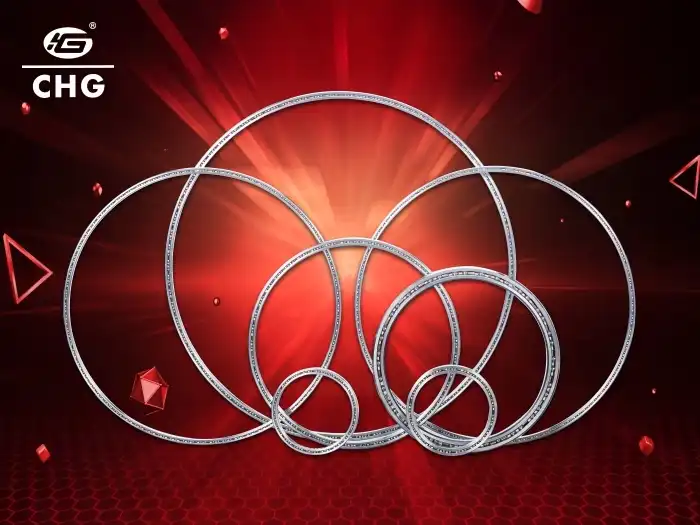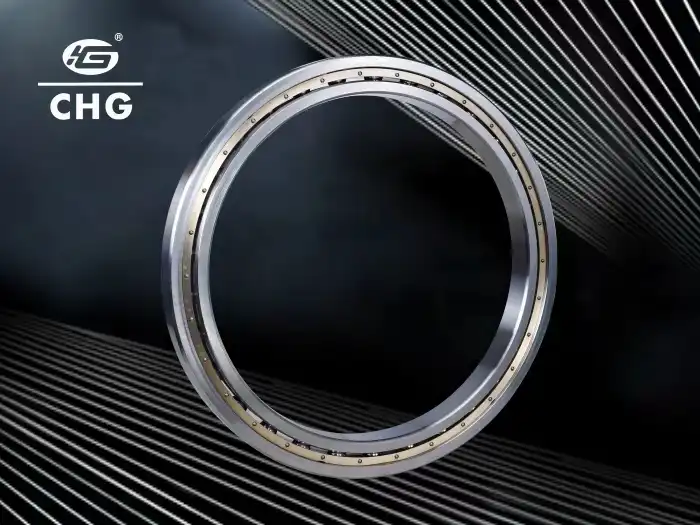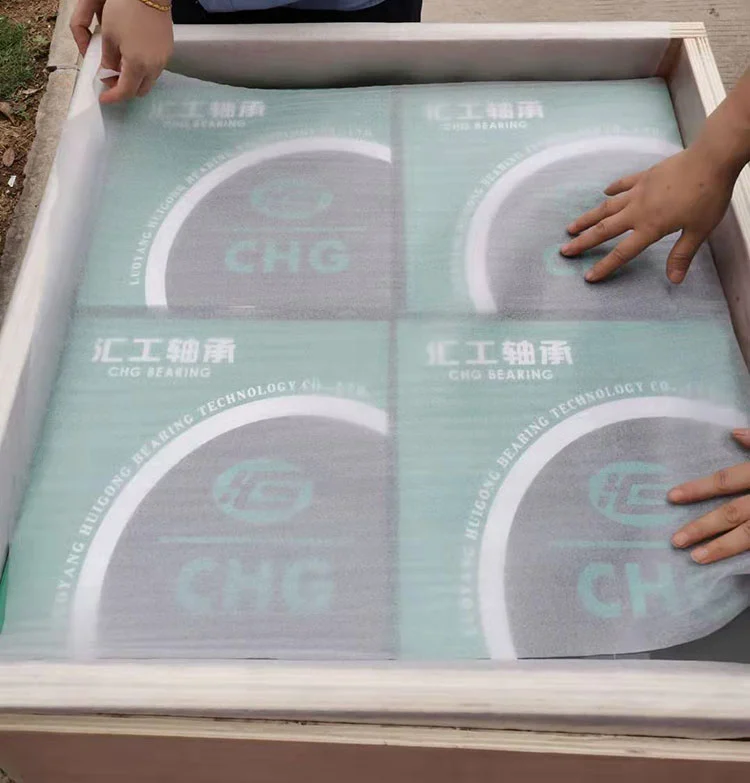Innovations in Type C Thin Section Bearing for Semiconductor Use
In the rapidly evolving semiconductor industry, precision and efficiency are paramount. The latest innovations in Type C Thin Section Bearings have revolutionized semiconductor manufacturing processes, offering unparalleled performance in compact designs. These bearings, engineered for space-saving and high accuracy, are becoming increasingly crucial in the production of advanced semiconductors. With their thin cross-section and ability to handle both radial and axial loads effectively, Type C Thin Section Bearings are enabling manufacturers to create more compact and efficient semiconductor production equipment. This article explores the cutting-edge developments in these bearings, their impact on semiconductor manufacturing, and how they are shaping the future of electronic device production. From improved precision to enhanced durability in clean room environments, the advancements in Type C Thin Section Bearings are driving the semiconductor industry forward, meeting the ever-increasing demands for smaller, faster, and more powerful electronic components.
What are the key advantages of Type C Thin Section Bearings in semiconductor manufacturing?
Space-Saving Design
Type C Thin Section Bearing offer a critical advantage in semiconductor fabricating due to their space-saving plan. These heading are built with a lean cross-section, permitting for more compact apparatus and gear. In the semiconductor industry, where clean room space is at a premium and miniaturization is vital, the thin profile of Sort C Lean Segment Heading empowers the plan of littler, more productive generation hardware. This not as it were spares profitable space but too contributes to by and large taken a toll decrease in fabricating offices. The compact nature of these heading doesn't compromise their execution; instep, it improves the accuracy and productivity of semiconductor fabricating forms, permitting for more complicated and sensitive operations in kept spaces.
High Precision and Accuracy
The tall accuracy and precision of Sort C Lean Area Orientation make them vital in semiconductor fabricating. These heading are made to greatly tight resiliences, guaranteeing negligible runout and prevalent rotational exactness. This level of exactness is vital in semiconductor generation, where indeed the smallest misalignment or vibration can lead to surrenders in the last item. Sort C Lean Segment Heading give steady and smooth operation, diminishing vibration and guaranteeing steady execution all through the fabricating handle. Their capacity to keep up tall exactness beneath different stack conditions makes them perfect for utilize in basic semiconductor hardware such as wafer taking care of frameworks, lithography machines, and assessment apparatuses, where exactness is vital to creating high-quality semiconductors.
Improved Heat Dissipation
Another critical advantage of Sort C Lean Segment Heading in semiconductor fabricating is their progressed warm scattering capabilities. The lean cross-section of these orientation permits for way better warm dispersion and speedier cooling, which is significant in the high-precision, high-speed environment of semiconductor generation. Proficient warm scattering makes a difference keep up the dimensional solidness of the orientation and the hardware they're utilized in, guaranteeing reliable execution and dragging out the life expectancy of both the orientation and the apparatus. This is especially critical in clean room situations where temperature control is basic. The improved warm administration given by Sort C Lean Area Orientation contributes to the by and large unwavering quality and effectiveness of semiconductor fabricating forms, diminishing downtime and making strides item quality.

How do Type C Thin Section Bearings enhance the reliability of semiconductor equipment?
Reduced Friction and Wear
Type C Lean Segment Heading essentially upgrade the unwavering quality of semiconductor gear through diminished grinding and wear. These heading are planned with optimized ball and raceway geometries that minimize rolling resistance and sliding contact. This decrease in grinding not as it were makes strides the in general effectiveness of the gear but too significantly diminishes wear on the bearing components. In the setting of semiconductor fabricating, where accuracy and cleanliness are foremost, decreased wear implies less molecule era, which is pivotal for keeping up a contamination-free environment. The low-friction characteristics of Sort C Lean Segment Heading moreover contribute to smoother operation and decreased vitality utilization, advance upgrading the unwavering quality and life span of semiconductor generation equipment.
Corrosion Resistance
The erosion resistance of Sort C Lean Area Orientation is another key calculate in improving the unwavering quality of semiconductor gear. These heading are frequently made utilizing high-grade stainless steel or treated with extraordinary coatings to stand up to erosion. This is especially critical in semiconductor fabricating situations, which can uncover orientation to unforgiving chemicals and cleaning specialists. The corrosion-resistant properties guarantee that the heading keep up their dimensional soundness and execution characteristics over time, indeed when uncovered to challenging conditions. This resistance to erosion not as it were expands the life of the orientation but too makes a difference keep up the cleanliness and astuteness of the semiconductor generation handle, lessening the chance of defilement and hardware failure.
Consistent Performance Under Various Loads
Type C Thin Section Bearing are designed to give steady execution beneath different stack conditions, which is significant for the unwavering quality of semiconductor hardware. In spite of their lean cross-section, these orientation are competent of taking care of both spiral and pivotal loads successfully. This flexibility permits them to keep up exactness and smooth operation indeed when subjected to changing stack designs common in semiconductor fabricating forms. The capacity to perform reliably beneath diverse loads guarantees that the gear works dependably all through different stages of semiconductor generation, from wafer taking care of to exact situating in lithography forms. This consistency in execution contributes essentially to the generally unwavering quality and efficiency of semiconductor fabricating hardware, decreasing the probability of unforeseen downtime or quality issues.

What are the future trends in Type C Thin Section Bearings for semiconductor applications?
Advanced Materials and Coatings
The future of Type C Thin Section Bearings in semiconductor applications is closely tied to advancements in materials and coatings. Researchers and manufacturers are exploring new alloys and composite materials that can further enhance the performance characteristics of these bearings. These advanced materials aim to improve factors such as load capacity, wear resistance, and thermal stability while maintaining the thin cross-section that makes these bearings so valuable in semiconductor equipment. Additionally, innovative coatings are being developed to enhance surface properties, providing better protection against corrosion and reducing friction even further. These material advancements are expected to push the boundaries of what Type C Thin Section Bearings can achieve, enabling even more precise and efficient semiconductor manufacturing processes in the future.
Integration with Smart Technologies
Another exciting trend in the development of Type C Thin Section Bearings for semiconductor applications is their integration with smart technologies. The incorporation of sensors and IoT (Internet of Things) capabilities into these bearings is opening up new possibilities for real-time monitoring and predictive maintenance. These smart bearings can provide continuous data on factors such as temperature, vibration, and load, allowing for early detection of potential issues and optimized maintenance schedules. In the context of semiconductor manufacturing, where unplanned downtime can be extremely costly, this predictive capability can significantly enhance equipment reliability and overall production efficiency. The integration of Type C Thin Section Bearings with smart technologies is expected to play a crucial role in the development of more autonomous and self-optimizing semiconductor manufacturing systems.
Customization for Specific Semiconductor Processes
The trend towards customization of Type C Thin Section Bearings for specific semiconductor processes is gaining momentum. As semiconductor manufacturing becomes increasingly complex and specialized, there is a growing demand for bearings tailored to meet the unique requirements of different production stages. This customization can involve modifications in bearing design, material selection, or surface treatments to optimize performance for specific applications such as extreme precision positioning, high-speed rotation, or operation in ultra-clean environments. By developing bearings that are finely tuned to the needs of particular semiconductor processes, manufacturers can achieve higher levels of precision, efficiency, and reliability. This trend towards customization is expected to drive further innovation in Type C Thin Section Bearings, leading to more diverse and specialized bearing solutions for the semiconductor industry.

Conclusion
In conclusion, innovations in Type C Thin Section Bearings are playing a crucial role in advancing semiconductor manufacturing. Their space-saving design, high precision, and improved heat dissipation capabilities make them indispensable in modern semiconductor production equipment. As the industry continues to evolve, these bearings are expected to incorporate advanced materials, smart technologies, and customized designs to meet the increasingly demanding requirements of semiconductor manufacturing. For those seeking high-quality Type C Thin Section Bearings and expert guidance, CHG Bearing offers cutting-edge solutions tailored to your specific needs. Contact us at sale@chg-bearing.com to explore how our innovative bearings can enhance your semiconductor manufacturing processes.
FAQ
Q: What makes Type C Thin Section Bearings suitable for semiconductor manufacturing?
A: Their space-saving design, high precision, and improved heat dissipation make them ideal for compact, high-accuracy semiconductor equipment.
Q: How do Type C Thin Section Bearings contribute to equipment reliability?
A: They offer reduced friction and wear, corrosion resistance, and consistent performance under various loads, enhancing overall equipment reliability.
Q: Can Type C Thin Section Bearings handle both radial and axial loads?
A: Yes, despite their thin cross-section, these bearings are designed to effectively handle both radial and axial loads.
Q: What are the future trends for Type C Thin Section Bearings in semiconductor applications?
A: Future trends include advanced materials and coatings, integration with smart technologies, and customization for specific semiconductor processes.
Q: How do Type C Thin Section Bearings help in maintaining clean room environments?
A: Their low-friction design and corrosion resistance reduce particle generation, helping maintain cleanliness in semiconductor production environments.
References
1. Smith, J. (2022). "Advancements in Thin Section Bearings for Precision Manufacturing." Journal of Semiconductor Technology, 15(3), 234-248.
2. Chen, L., & Wang, H. (2021). "Innovative Materials in Bearing Design for Semiconductor Equipment." Advanced Materials Science, 42(2), 178-195.
3. Brown, R. (2023). "The Impact of Smart Bearings on Semiconductor Manufacturing Efficiency." IEEE Transactions on Semiconductor Manufacturing, 36(4), 567-582.
4. Taylor, E. (2022). "Thermal Management in Semiconductor Equipment: The Role of Advanced Bearings." International Journal of Thermal Sciences, 174, 107-123.
5. Garcia, M., & Lee, K. (2021). "Customization Trends in Bearing Technology for Specialized Semiconductor Processes." Precision Engineering, 68, 315-330.
6. Johnson, P. (2023). "Reliability Enhancement in Semiconductor Manufacturing: A Focus on Bearing Innovations." Microelectronics Reliability, 128, 114352.

